We are reader-supported. Buying through any red colored link on our site may earn us commissions. Learn More.
Up to 30% off engagement rings and select jewelry at James Allen!
Blue sapphire engagement rings feature a blue sapphire gemstone as the centerpiece, offering a vibrant alternative to the traditional diamond engagement ring. Blue sapphires are cherished for their deep, enchanting hues and are second only to diamonds in hardness, making them a durable choice for an engagement ring that can stand the test of time. When shopping for a blue sapphire engagement ring, it’s crucial to pay attention to the 4 Cs: color, clarity, cut, and carat weight, with color being the most critical factor for sapphires. Aim for a stone that has a rich, velvety blue hue without any gray undertones.
When it comes to purchasing a blue sapphire engagement ring, always opt for reputable jewelers and ensure that the stone is certified from a recognized gemological lab. Be cautious of stones that are labeled as “natural” but are, in fact, treated to enhance their color or clarity. While treatments are standard in the industry, disclosure is crucial for fair pricing. Some prefer untreated stones for their natural beauty and rarity, even though they might command a higher price. Always do your due diligence before making a purchase, and don’t shy away from asking for documentation or certification to validate the stone’s quality.
Why you should trust us
Bottom Line Recommendation
A blue sapphire can look elegant and stunning as an engagement ring center stone, with a rich color that sets it apart from other gemstones.
In general, buying a blue sapphire engagement ring is less technical than buying a ring with a diamond center stone. Because clarity and cut aren’t as important as they are with a diamond, it’s best to focus on finding a blue sapphire with the most impressive, captivating color.
Because of this, we recommend shopping for a blue sapphire engagement ring from a trusted vendor that provides high-resolution photos with accurate color representation, such as James Allen or Leibish & Co.
What Are Blue Sapphires?
Blue sapphires are the most popular and valuable blue colored gemstone of the Corundum mineral family. Corundum is the second hardest natural mineral used for jewelry after diamonds, scoring a 9 on the Mohs scale of hardness, and is also the mineral that produces ruby gemstones.
While sapphires can come in a variety of colors, blue is the most common and most sought-after. Blue sapphires can have a range of hues, from a light, pale blue, to a deep and vivid color.
Blue sapphires can also have a hint of green or purple mixed in. As long as the secondary color does not make up more than 15% of the gem’s color, these are still referred to as blue sapphires. However, a sapphire with a secondary color is not as valuable and desirable as one with a pure blue shade.
As the most well known of the sapphire colors (pink, yellow, white, green …), blue sapphires offer a unique beauty that’s made them a favorite of royalty for centuries. Recently, this popularity has spread to the world of bridal jewelry.
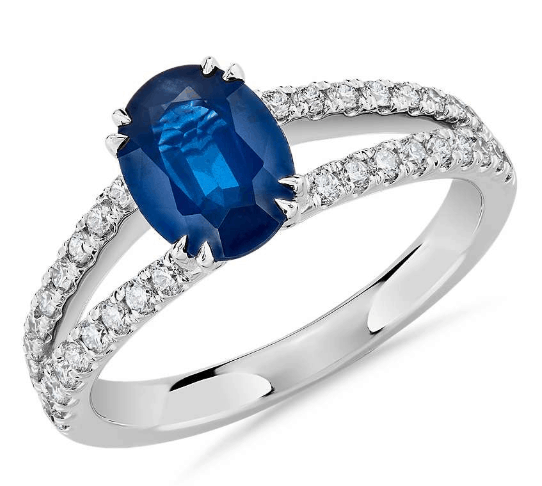
Blue sapphires have been a popular engagement ring center stone for decades, with an elegant appearance that’s made them a popular alternative to diamonds. However, they’re really shot up in popularity since 2010, when Kate Middleton’s stunning blue sapphire engagement ring made headlines.
While buying an engagement ring featuring a diamond is all about maximizing the 4 Cs (cut, color, clarity and carat), shopping for a blue sapphire engagement ring is quite a different process. Generally, cut and clarity aren’t quite so important, while color is essential.
For more examples of what blue sapphire engagement rings can look like, feel free to browse through recently purchased rings from our highest-rated retailers.
We’ve covered this in more detail below, along with actionable tips to help you buy the highest quality blue sapphire engagement ring for your budget.
Blue Sapphire Engagement Ring Meaning
A blue sapphire engagement ring represents a unique personal style, with a vivid colored gemstone instead of a white diamond. Blue sapphire engagement rings appeal to brides who desire color in their ring or want an engagement ring that stands out from the crowd.
Kings and other royalty, as well as historical figures, have worn blue sapphire jewelry due to its association with good fortune. In fact, blue sapphires have been precious gemstones for thousands of years. For several religions, the deep blue hue of sapphire is viewed as a representation of heaven.
As September’s birthstone, giving a blue sapphire engagement ring can be a special, meaningful way to propose if your fiancé-to-be has a birthday in this month.
Our guide to sapphires goes into greater detail about the historical significance of sapphires, as well as the origins of “sapphire” as a name.
Beyond their historical significance, blue sapphires are versatile, durable center stones that are ideal for engagement rings. Sapphires score 9/10 on the Mohs’ scale of hardness, making them second only to diamonds in terms of scratch resistance and overall durability.
Famous Blue Sapphire Engagement Rings
Although blue sapphire engagement rings have grown hugely in popularity over the last decade, this richly-colored gemstone has been one of the favorite center stones of royalty and important figures for centuries.
Right now, the most famous blue sapphire engagement ring is undoubtedly Kate Middleston’s stunning 12-carat oval blue Ceylon sapphire ring. First purchased by Prince Charles in 1981, it was famously worn by Princess Diana throughout their marriage. The iconic ring was reportedly inspired by a piece of jewelry commissioned for Queen Victoria in 1840.
While Kate Middleton’s is undoubtedly the most well-known royal sapphire engagement ring at the moment, it’s far from the only historical example. In 1795, when Napoleon proposed to his future bride Josephine, he did so with a unique “You and Me” blue sapphire and diamond ring.
What to Look For in a Blue Sapphire Engagement Ring
As we’ve covered in our guide to the diamond’s 4 Cs, buying a diamond is all about understanding how factors such as cut, color, clarity and carat weight affect a diamond’s value, then maximizing the visible factors that contribute to the beauty of the diamond you choose.
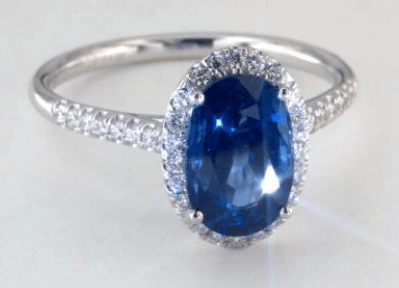
Buying a blue sapphire is a little different. While a diamond is treasured for its brilliance, a blue sapphire is primarily treasured for its color.
This means that while factors like cut and clarity are crucial to a diamond’s appearance, they’re less important than factors like color for a blue sapphire.
Color
A natural, “true” blue color is the biggest visual factor that affects a blue sapphire’s value. For the most part, the closer you get to a “true” blue, the higher the quality of the sapphire and the more it will cost to purchase. The color of blue sapphire can be powerful and extremely attractive — as the GIA explains, a gorgeous can look “like it’s lit from within.”
Blue sapphires can range in color from a pure, “cornflower” blue to blue with slight hints of green or purple. Generally, the more visually obvious the hints of green or purple are, the less valuable the sapphire becomes.
Two factors that can affect a sapphire’s color are its tone and saturation. Tone refers to how light or dark the blue color of the sapphire is. A lighter tone can make a sapphire appear washed out and less impressive, while an overly dark tone can make the blue color harder to see.
When it comes to tone, it’s best to stick with a sapphire that sits in the middle of the range, with a blue that’s strong enough to see clearly but not so dark that the details of the gemstone can’t easily be seen.
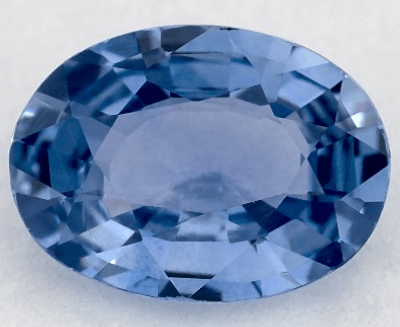
As for saturation, the highest quality sapphires tend to have rich, consistent and vivid color that’s free of brown or gray areas.
The best color for a blue sapphire is royal blue, also known as cornflower blue. You can recognize these stones because of their medium to dark blue hue with high saturation. Sapphires of this color are vivid and devoid of brown and gray hints. Some people prefer a violet-blue tone in the same color range with high saturation.
Unlike diamonds, which are graded for color using an objective, standardized system, sapphires aren’t graded for color using any kind of standardized scale. This makes it important to shop for blue sapphire engagement rings from a vendor that provides accurate, high-quality photos.
For blue sapphire engagement rings and other jewelry, we recommend James Allen and Leibish & Co., both of whom offer excellent, high-resolution photographs of their inventory.
Clarity
All sapphires will contain inclusions called rutile needles, making it extremely uncommon to find a flawless, inclusion-free blue sapphire. The vast majority of sapphires are also heat treated for improved clarity and color.
In general, inclusions are less of an issue with blue sapphires than they are with diamonds. To inspect a diamond for inclusions, a gemologist will typically use a 10x magnification loupe. With a sapphire, a gemologist usually won’t use any magnification at all during their inspection.
Most of the time, if a blue sapphire is “eye-clean,” meaning it has no obvious inclusions that are visible to the naked eye, its clarity is acceptable for an engagement ring or other jewelry.
“Inclusions generally make gemstones less valuable, but they can increase the value of sapphires that exhibit asterism—or stars—the four- or six-rayed star pattern of light produced by the fibrous inclusions, elongated needles, or growth tubes in a gemstone. This singular, celestial-like phenomenon is best seen in a gemstone cut en cabochon.” American Gem Society (AGS)
Cut
Unlike with a diamond, there are no standardized cuts for blue sapphires. To look its best, a blue sapphire should be cut symmetrically and reflect light at the correct angles to display the stone’s beauty and luster.
The most popular cuts for a blue sapphire tend to be oval, round cushion and emerald. There’s no “best” cut for a blue sapphire, allowing you to choose something that matches your fiancé-to-be’s tastes and personality.
Carat Weight
Like diamonds, blue sapphires come in an incredible range of carat weights. Because sapphires tend to be heavier than diamonds, a one carat blue sapphire will often look slightly smaller than a diamond of equivalent carat weight.
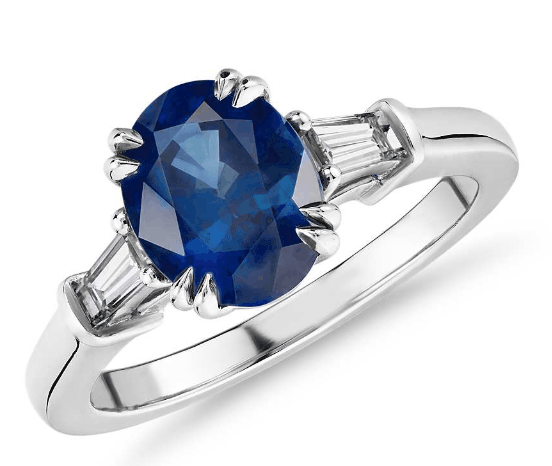
Because of this, it’s important to look at carat weight and measurements when you’re comparing blue sapphires. To make this easier, vendors like James Allen list measurements for each loose sapphire in their inventory.
Where to Buy a Blue Sapphire Engagement Ring
As we mentioned above, the best places to buy a blue sapphire engagement ring are James Allen and Leibish & Co.
Both of these vendors are trusted, offer the best pricing in the industry and provide high-quality photos of their inventory (this is essential for checking a sapphire’s color). They both also offer numerous high-quality engagement ring settings — something we’ll cover in more detail later.
There are a few key differences between James Allen and Leibish & Co. that you’ll want to be aware of before shopping. We’ve listed these below, as well as more information on the main advantages of each vendor.
James Allen
James Allen is one of the largest online retailers of diamonds, gemstones, engagement rings and other high-quality jewelry. Although they’re best known for their diamonds, they also stock one of the largest selections of blue sapphires of any online vendor.
Currently, James Allen’s loose blue sapphire selection features almost 5,000 different stones in varying sizes and cuts.
One advantage of shopping at James Allen is that they have a great selection of blue sapphires in the one to two carat range. These sapphires are typically less expensive than diamonds of an equivalent carat weight, allowing you to affordably maximize the size of your center stone.
For example, this stunning 1.78 carat round natural blue sapphire is priced at $2,230. Set in this beautiful 14k white gold pave engagement ring, you have an elegant, gorgeous ring that’s priced at just over $3,000.
This 2.93 carat oval natural blue sapphire is also a great choice. Available for $5,360, it can look fantastic in a range of settings, including this beautiful 14k white gold knife edge solitaire setting, available for an additional $405.
As we’ve covered in our James Allen review, James Allen is a great place to shop for any type of engagement ring. Their customer service is top notch, their return policy is very generous to customers and their pricing is some of the best in the business.
Leibish & Co.
Leibish & Co. is another great place to buy a blue sapphire engagement ring. While their range of blue sapphires isn’t as vast as James Allen’s, they stock a great selection of high-quality Sri Lankan and Burmese sapphires, many of which haven’t been heat treated.
As we mentioned in our guide to sapphires, sapphires that haven’t been heat treated are rare and exceptionally valuable.
This stunning 2.47 carat Burmese blue sapphire is available from Leibish & Co. for $16,600. It has a gorgeous deep blue hue and no signs of heat treatment. Set in this 18k white gold halo engagement ring setting, it costs a total of $21,190.
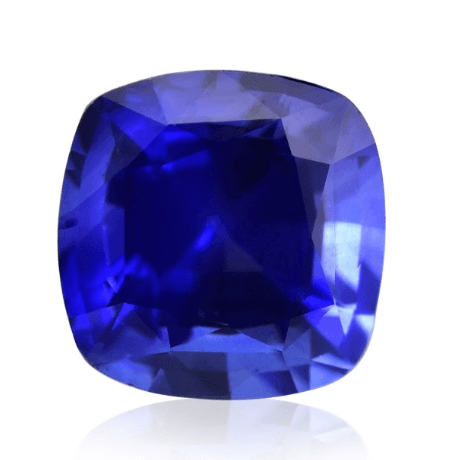
Although Leibish specializes in high-end sapphires, they also have a diverse selection of more affordable stones. This gorgeous 1.83 carat cornflower blue Sri Lankan sapphire is available at a price of $2,650. In this classic solitaire setting, it costs a total of $3,900.
Like James Allen, Leibish & Co. offer excellent customer service. All of their loose gemstones, rings and other jewelry come with free, fully insured shipping worldwide, certification and a 30-day money back guarantee. You can learn more about them in our Leibish & Co. review.
Tips for Choosing the Best Blue Sapphire Ring
As we mentioned above, buying a blue sapphire engagement ring is less technical than buying a diamond. Despite this, there is a range of ways that you can maximize your value for money and get the highest quality center stone and ring for your budget:
- Choose the right metal. Although blue sapphires can look great in any type of setting, they tend to look best alongside white metals, such as white gold and platinum. These metals emphasize and complement the deep blue color of the sapphire.
- Consider a halo setting. Blue sapphires can look particularly beautiful when they’re surrounded by a halo of small diamonds. Halo settings are perfect for emphasizing the beauty and size of a round blue sapphire.
- Check the sapphire’s measurements. As we mentioned above, blue sapphires are usually heavier than diamonds of the equivalent size. Because of this, it’s important to check the measurements as well as the carat weight when sizing up a sapphire.
- Don’t worry too much about heat treatment. The vast majority of blue sapphires on the market undergo heat treatment for improved color and clarity. This is a very normal, common process that doesn’t cause any damage to the sapphire.
As such, it’s best not to worry about heat treatment. If you’re searching for an untreated sapphire, expect to pay significantly more for it than you would for a heat-treated sapphire of the equivalent carat weight. - Focus on color, not clarity. Unlike diamonds, which often only have tiny inclusions, it’s very rare for a sapphire to have no inclusions at all. If a sapphire is “eye-clean,” meaning it’s free of inclusions to the naked eye, it should look excellent in a ring.
- Pay close attention to the photos. The tone and saturation of a blue sapphire have a huge impact on its appearance. When you’re comparing sapphires, use the high-quality photos offered by merchants like James Allen and Leibish & Co. to assess their color.
If you’re shopping from your phone or tablet, check that the brightness is turned up high enough to provide an accurate representation of the sapphire’s tone, saturation and the presence of any hints of green or purple.
Shop for blue sapphire engagement rings here.
If you need more help buying a blue sapphire engagement ring or any other jewelry, feel free to contact us. Our experts can help you find the highest quality sapphire engagement ring for your budget.
Here are more specific gemstone topics to browse:
- What to consider when buying gemstone jewelry
- What is there to know about a Sapphire gemstone
- White Sapphire: What is it and how to shop for one?
- Green Sapphire: What is it and how to get one?
- Pink Sapphire: How to get the best value?
- How to choose a Yellow Sapphire for an engagement ring?
- What is a Ruby gemstone?
- How to buy green Emerald jewelry?
- Tips for buying Moonstone engagement rings
- How much do Amethyst gemstones cost?
- What is an Opal stone?
- How much to spend on a Peridot engagement ring?
- What’s the difference between Natural and Cultured Pearls?
- Pros & Cons of buying a Morganite engagement ring
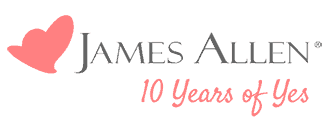
- No questions asked returns within 30 days of shipment. James Allen will send you a paid shipping label to return the ring.
- Lifetime Warranty
- Free International Shipping
- Free prong tightening, repolishing, rhodium plating and cleaning every 6 months
- Provide insurance appraisals
- One free resizing within 60 days of purchase
- Free ring inscriptions
- Best-in-class high quality imagery of all diamonds in stock
- 24/7 Customer Service
- Best-in-class packaging


- No questions asked returns within 30 days of shipment. Blue Nile will send you a paid shipping label to return the ring.
- Lifetime Warranty
- Free Shipping
- Free prong tightening, repolishing, rhodium plating and cleaning every 6 months
- Provide insurance appraisal
- One free resizing within the first year of purchase
- High quality images of about half of their diamonds
- 24/7 Customer Service
- 100% credit towards future upgrades (must be at least double in value)
- Best in class fulfillment

Still afraid of getting ripped off?
Before you buy a diamond, get personal buying advice from industry veterans. We'll help you get the best diamond for the money.
Ask your diamond purchase question here
DISCLAIMER: We don't use your email for marketing. Period.
You Might Like
Diamond Prices: A Complete Guide
A diamonds’ price is determined primarily by the 4 Cs of the diamond. On the wholesale level, diamond prices are first based on a diamond shape and
The Best Places to Buy Engagement Rings
Buying an engagement ring is often one of the first major purchases in a person's life. The process can be fraught with tension as there are so m
1 Carat Diamond Price & Buying Guide
A wide range of 1 carat diamonds exist both in online markets and local diamond jewelry stores. Not only are there significant differences in beauty



